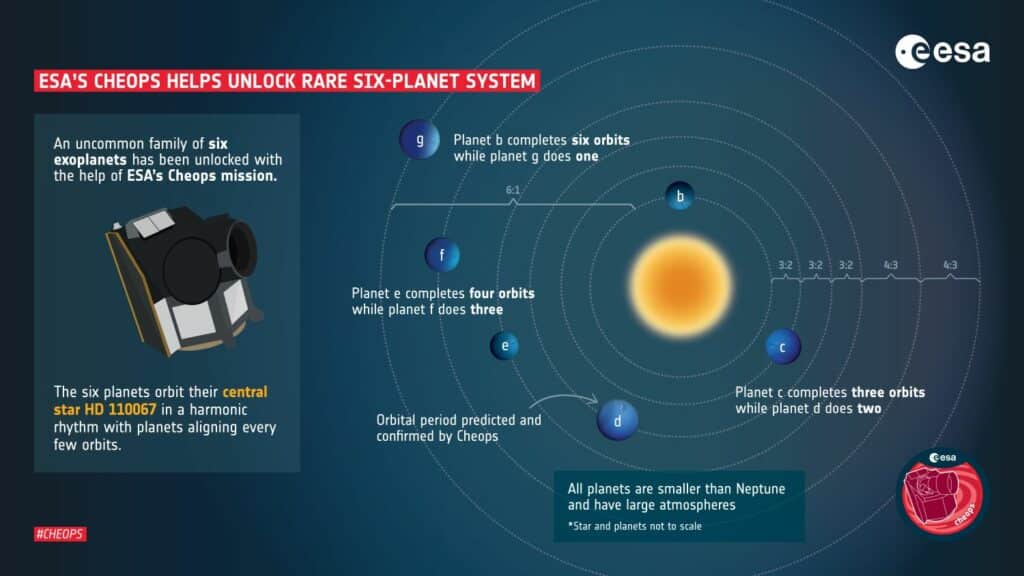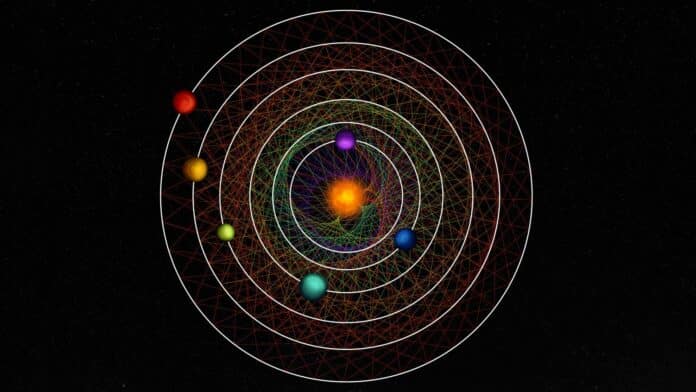More than half of all Sun-like stars have close-in orbits containing planets with radii between Earth and Neptune. Nevertheless, their composition, formation, and evolution still need to be well known. Investigating the results of planet creation and evolution while accounting for initial conditions and environment is made possible by studying multi-planetary systems. Resonant systems, characterized by orbital durations related by a ratio of tiny integers, are especially significant since they suggest a system architecture that has remained unaltered since the system’s inception.
ESA‘s CHaracterising ExOPlanet Satellite (Cheops) has provided crucial data to understand a mysterious exoplanet system that has perplexed researchers for years.
The star HD110067 is located in the northern constellation Coma Berenices, around 100 light-years away. In 2020, NASA’s TESS detected dips in the star’s brightness, indicating planets were passing before the star’s surface.
Two planets were identified during a preliminary examination. One had an orbital period of 5.642 days, the amount of time it takes to complete one orbit around the star; the other’s period was indeterminate.
TESS made another observation of the same star two years later. The original interpretation was ruled out, but the combined data suggested the combined data but two different planets set analysis. Even though these discoveries were far more specific than the initial ones, many things about the TESS data remained puzzling.

There comes ESA’s Cheops. Using Cheops, scientists confirmed the existence of a third planet in the system. They realized that by establishing that the three planets were in an orbital resonance, they had discovered the key to opening up the entire system. The orbital period of the outermost planet is 20.519 days, over 1.5 times that of the next planet, which has an orbital period of 13.673 days. This, in turn, is nearly 1.5 times the inner planet’s orbital period, or 9.114 days.
Rafael said, “Predicting other orbital resonances and matching them to the remaining unexplained data allowed the team to discover the other three planets in the system. Cheops gave us this resonant configuration that allowed us to predict all the other periods. Without that detection from Cheops, it would have been impossible.”
Discovering orbitally resonant systems is crucial because it informs astronomers about the planetary system’s genesis and subsequent evolution. Although planets orbiting stars frequently develop in resonance, they are also easily disturbed.
For instance, a giant planet, a near encounter with a passing star, or a massive impact event could disturb the delicate balance. Because of this, many of the multi-planet systems that astronomers are aware of are not in resonance but appear to have been resonant at some point. Multi-planet systems that maintain their resonance are uncommon, nevertheless.
Rafael said, “We think only about one percent of all systems stay in resonance. That’s why HD110067 is special and invites further study. “It shows us the pristine configuration of a planetary system that has survived untouched.”
Maximilian Günther, ESA project scientist for Cheops, said, “As our science team puts it: Cheops is making outstanding discoveries that sound ordinary. Out of only three known six-planet resonant systems, this is now the second one that Cheops found in only three years of operations.”
Journal Reference:
- Luque, R., Osborn, H.P., Leleu, A. et al. A resonant sextuplet of sub-Neptunes transiting the bright star HD 110067. Nature 623, 932–937 (2023). 10.1038/s41586-023-06692-3
